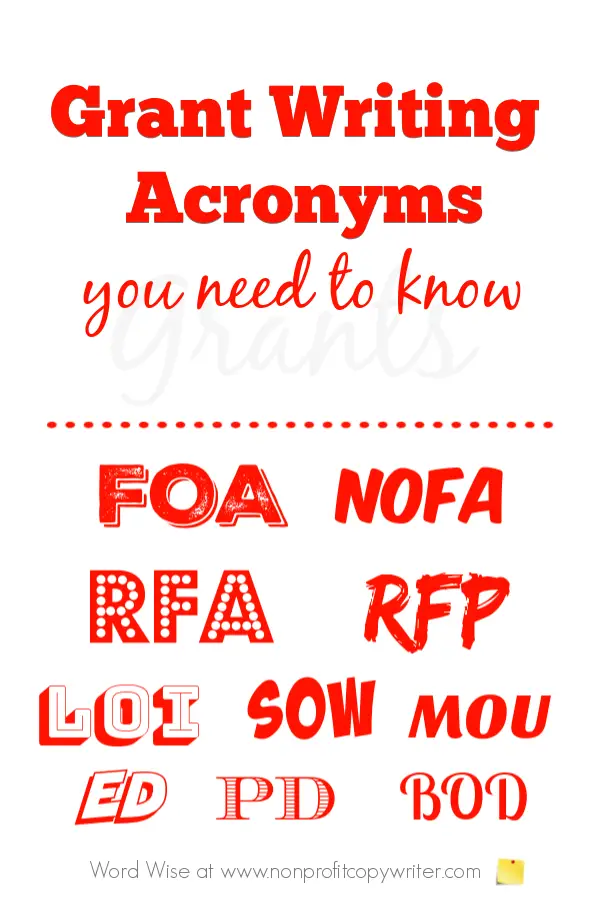Save Time: Get 5 Simple Writing Tips
you can put to use in 10 minutes
Grant Writing Acronyms You Need to Know
Award-winning writer Kathy Widenhouse has helped hundreds of nonprofits and writers produce successful content , with 750K+ views for her writing tutorials. She is the author of 9 books. See more of Kathy’s content here.
“I need to learn a whole new language.”
That was my first thought when I dipped my toe into grant writing for nonprofits.
I soon learned that grant-speak extends beyond government grants to private foundation and corporation funding operations, too.
What surprised me the most were the acronyms – terms formed from abbreviations using the initial letters of other words. Twenty years in the military had acclimated me to acronyms. But to incorporate these abbreviations in grant making? To me, it seemed that funders could simply use regular words in the application and award process instead of going all bureaucratic on us.
Then I came to understand that grant writing can be complex. Acronyms serve a special purpose: simplification. They are a type of shorthand. Those involved in the grant process have compressed the terminology to make communication clearer and quicker.
No, you needn’t learn a whole new language. Just learn a few key acronyms and you’ll understand the grant process better. Here are a few that confused me when I first started writing grants. Now you’ll be a step further into understanding the process so you can get to the writing part quicker.
Key Grant Writing Acronyms
FOA (Funding Opportunity Announcement) or NOFA (Notice of Funding Availability)
Usually published by a government entity, a FOA or NOFA announces the agency’s plan to award grants in a particular area. Since government grant applications are long and complex, a FOA allows you to think ahead so you have time to prepare your application.
RFA (Request for Applications) or RFP (Request for Proposals)
An RFA is an official solicitation for applications. A typical RFA outlines applicant eligibility, project eligibility, amount of funding available, the timing of both the submission the evaluation process, submission procedures, and other key information. (Check out these elements of a grant proposal.) While many private and corporate foundations are not required to issue RFPs (as are government agencies), some do so in order to launch a new project or announce changes to an annual award.
LOI: Letter of Inquiry
Increasingly, funders request that you submit a Letter of Inquiry (LOI) before preparing a full grant proposal so they can screen for strongest candidates, plan for adequate staff to review submissions, and to build a qualified recruitment list to notify about future grant opportunities. An LOI is a brief (1-2 page) letter that introduces your organization, presents a statement of need, summarizes your proposed project, and explains why this project or methodology is a solution to the need. Funders may specify LOI requirements or page/word count. (Here's how to write a Letter of Inquiry.)
SOW: Statement of Work, Scope of Work, Summary of Work
No, it’s not a female pig. A Statement of Work is part of a project description in a grant proposal. You’ll use the SOW section to outline in detail how you will carry out the proposed project.
MOU: Memo of Understanding
You’re a nonprofit. You work with other community organizations. Those agencies provide services that complement yours – and your services complement theirs. Do you have a written agreement about your partnership with those collaborators? Answer yes, and you’ve likely got an MOU – a non-binding written agreement that outlines what each of you contribute to the other. Funders like to see copies of MOUs as part of the grant making process. Doing so demonstrates that you’re not replicating (rather you’re complementing) other available services … and that you know how to play nice in your local sandbox.
Key People in the Grant Writing Process
ED: Executive Director
Typically, your organization’s lead. The ED may also serve as the CO (Contracting Officer) for the grant.
PD: Program Director
The staff member who is responsible for leading the project for which you’re applying for funding.
BOD: Board of Directors
In the end, these good folks are the ones that vote yes or no on everything your nonprofit undertakes. Be good to them.
More Grant Writing Tips
Screen a Grant Opportunity and Increase Your Chances of an Award ...
My Top Grant Writing Tip: It's Not about Writing, After All ...
Nail the 5 Stages to Writing a Grant ...
Grant Writing for Beginners: getting started with the fundamentals ...
Grant Writing Made Simple: 7 elements of a grant proposal ...
How To Read a Grant Application So You Can Write a First-Class Grant ...
Grant Writing: How to Write a Letter of Inquiry ...
Grant Application Attachments Checklist: Get Organized, Save Time ...
5 Important Tips for Writing Objectives: Be S.M.A.R.T. ...
Free Grants Listing to help you get started ...
Get more Writing Tips for Grants on our Pinterest board...
Return from Grant Writing Acronyms to Nonprofit Copywriter home
As an Amazon Associate I earn from qualifying purchases.
Share This Page

Named to 2022 Writer's Digest list
BEST GENRE/NICHE WRITING WEBSITE


Stop Wasting Time!
Grab your exclusive FREE guide, "5 Simple Writing Tips You Can Put to Use in 10 Minutes or Less"












